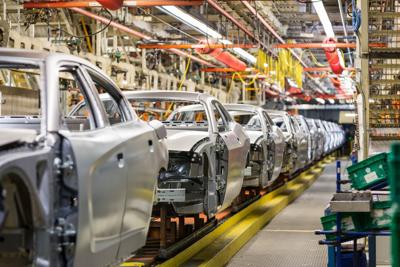U.S. President Donald Trump’s decision to impose steep tariffs on all passenger vehicles made outside the U.S. has hit the Canadian auto manufacturing industry like an 18-wheeler.
The levies, which came into effect April 3, include on all cars, vans, SUVs and light trucks imported to the U.S. and would also apply to key auto parts including engines, transmissions and electrical components.
In turn, Prime Minister Mark Carney will be levying a 25 per cent countertariff on imported American automobiles.
These tariffs are already creating massive disruptions in Canada’s auto sector.
Jayson Myers, the CEO of , the nonprofit national network that leads Canada’s Global Innovation Cluster for Advanced Manufacturing, says there will be immediate ramifications for costs, cash flow and supply chains.
‚ÄúCar companies don‚Äôt have a lot of margin to absorb these additional costs,‚ÄĚ he says, noting that the strain could lead to closures and layoffs. (Indeed, Windsor‚Äôs Stellantis has already announced plans to shut down its plant for two weeks, affecting 4,500 workers.)
Myers says that Canada needs to¬† be ‚Äúvery cautious‚ÄĚ in applying any countertariffs that could dramatically increase production costs here at home. Among his recommendations: tariff-related rebates to stabilize the auto industry, tax credits for R&D and reforms to the country‚Äôs tax credit system that would drive the development of new equipment and technologies.
Although the , Myers suggests savvy ventures may find opportunities amid this tariff upheaval.
‚ÄúThe value in cars is largely in the technology, and the competitiveness of the auto companies is largely based on efficiency, flexibility and smart automation systems,‚ÄĚ he says. If Canadian innovators are able to develop truly unique tech for the sector, Myers continues, ‚ÄúThey‚Äôre going to beat the pants off any American company in the future.‚ÄĚ
Canadian tech takes hold in Hannover
This week marked the conclusion of , a massive industry and energy tech sector trade show based in Hannover, Germany.
Because NGen was leading the Canadian delegation at the event, Jayson Myers was on hand to observe that there was strong interest in the country’s innovators, many of whom were able to forge new connections.
‚ÄúEverybody‚Äôs getting leads and finding potential technologies or suppliers,‚ÄĚ he says.
Ironically, his sense is that many of the business dealings are between Canadian companies.
‚ÄúFor some reason, you have to travel outside of Canada to understand what other Canadian companies are doing.‚Ä̬†
Among the CanCon highlights: Durham Region’s , a collaborative initiative to build a fully Canada-made electric vehicle; tech, which produces low-carbon energy using any heat source; and , which is unveiling MAST (Manufacturing Source of Truth), a modular digital platform intended to help manufacturers optimize operations by connecting machines, sensors, quality-assurance systems and people.
Synaptive SOS
Tariffs have already had detrimental effects for Canadian companies outside the auto sector.
, which builds X-ray and MRI machines and surgical robots, has entered bankruptcy protection and is now in court-ordered restructuring, with 125 jobs on the line.
According to president and co-founder Cameron Piron, economic uncertainty has undermined the company’s ability to raise funding, as American investors have hit pause while they sort out the implications of tariffs.
M-Lab consortium’s CDR collaboration
M-Lab, a Japanese consortium of companies including Mitsubishi Corporation, ENEOS Americas, Mitsubishi Research Institute, Tokio Marine Holdings Inc. and Yakazi Innovations Inc., has been MaRS Discovery District on a carbon dioxide removal credit purchase and education program, with the aim of empowering the participants to establish their own CDR purchase processes in the future. 
The partnership also involved soliciting applications from promising early-stage Canadian CDR companies to provide e-credits over a period of three years as a demonstration of market traction.
MaRS has pre-purchased carbon credits from the six applicants who were selected: , , and .
CIBC commits to GenAI code of conduct
In 2023, the federal government proposed a code of conduct for generative AI that encompassed six key principles, including equity, transparency and human oversight. The hope is that companies who deploy this technology will sign on, although participation is voluntary. Last week, CIBC announced that it had made a commitment to comply with the guidelines, noting that it is the first major bank to do so.
By the numbers
40: The percentage of ’s workforce laid off as a result of the U.S. tariff impacts. The company’s founder and CEO, Katherine Homuth, has also stepped down as part of ongoing efforts to close a $40-million fundraising deal. U.S. clients account for 85 per cent of Sheertex’s sales.
$5.6 million: St. John’s, Nfld.-based will receive to help develop its AI tech thanks to a partnership involving the Hibernia and Hebron oil rigs anchored off the coast of Newfoundland, which are owned by major oil companies like ExxonMobil, Chevron and Suncor.
US$45 million: The awarded to Ranovus, a Canadian company that makes multi-terabit circuits for speedy data transmission, in conjunction with U.S. computer chip manufacturer Cerebras Systems, as part of a deal with the U.S. military.
35: T in Aurora quantum computing system. The Toronto-based venture is one of three Canadian companies (the others are Photonic Inc. and Nord Quantique) among the 18 initial qualifiers in the , a challenge overseen by the U.S. government’s Defense Advanced Research Projects Agency (DARPA), in which contenders could receive as much as US$316 million if they can provide evidence, within eight years, that their quantum tech works at scale.



























To join the conversation set a first and last name in your user profile.
Sign in or register for free to join the Conversation